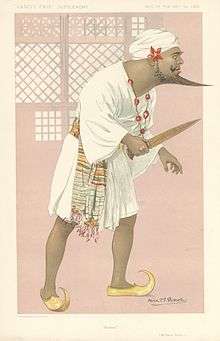Kismet (play)
Kismet is a three-act play written in 1911 by Edward Knoblauch (who later anglicised his name to Edward Knoblock). The title means Fate or Destiny in Turkish and Urdu. The play ran for two years in London and later opened in the United States. It was subsequently revived, and the story was later made into several films and the popular 1953 musical.
History

Kismet was first produced by Oscar Asche at the Garrick Theatre, London, on 19 April 1911. Knoblock wrote the play for Asche, with the understanding that Asche could revise it. He shortened and partly re-wrote it and produced it with much success, playing Hajj, the leading man, with Lily Brayton as Marsinah, the leading lady. The costumes were designed by Percy Anderson. The production was so popular that it ran for two years.
The play was then accepted by the Theatrical Syndicate, and staged at the Knickerbocker Theatre in New York, produced by Harrison Grey Fiske. It opened on Broadway on Christmas Day 1911, and the leading roles were then taken by Otis Skinner and Rita Jolivet. This production also gained considerable popularity.
Asche led a successful tour of the play in Australia in 1911–12, and upon his return to London, he revived Kismet. Asche and Brayton appeared in a 1914 film of the play. It was later filmed in 1920, 1930 and 1944. Skinner played Hajj in the 1920 and 1930 film versions.
In 1953, the story was adapted into the famous musical by Robert Wright and George Forrest, with themes from the music of Alexander Borodin. The musical was, in turn, adapted for film in 1955.
References
Full text
External links
| Wikimedia Commons has media related to Kismet (play). |
- Kismet (1914) at IMDB
- Kismet in The Playgoerand Society Illustrated, Vol. IV, No. 20 (1911)
- Kismet in The Play Pictorial, Vol. XVIII, No. 106 (1911)